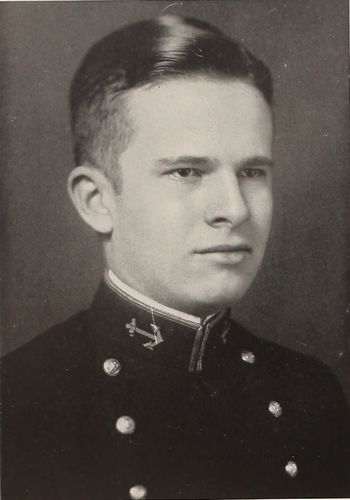JOHN W. HAYS, LTJG, USN
John Hays '36
Lucky Bag
From the 1936 Lucky Bag:
Jack W. Hays
Tulsa, Oklahoma
"Jack"
"Two gun," after getting the old sea urge, left Oklahoma, land of Indians, oilwells, and wrestlers, and packed up for Annapolis. After his arrival, it didn't take long for Jack to get established in this new type of life, although he has never forgotten the old. During the winter months, when so many join the radiator club, the Kid may be found in the wrestling loft. In the spring, Jack may be seen in drill dress heading for the riding stables. One can never tell as to Jack's academic abilities, as he visits all sections from first to anchor. He is far from being wooden, however, and always keep well above the old 2.5. Whether on the sea, in the big city, or on the plains, we know Jack will be a success and will be a real friend to all.
Water Polo Manager 4; Battalion C.P.O.

Jack W. Hays
Tulsa, Oklahoma
"Jack"
"Two gun," after getting the old sea urge, left Oklahoma, land of Indians, oilwells, and wrestlers, and packed up for Annapolis. After his arrival, it didn't take long for Jack to get established in this new type of life, although he has never forgotten the old. During the winter months, when so many join the radiator club, the Kid may be found in the wrestling loft. In the spring, Jack may be seen in drill dress heading for the riding stables. One can never tell as to Jack's academic abilities, as he visits all sections from first to anchor. He is far from being wooden, however, and always keep well above the old 2.5. Whether on the sea, in the big city, or on the plains, we know Jack will be a success and will be a real friend to all.
Water Polo Manager 4; Battalion C.P.O.
Loss
John was lost when USS Asheville (PG 21) was sunk by Japanese surface forces on March 3, 1942. There was only one known survivor of the sinking.
Other Information
From the Class of 1936's "Golden Lucky Bag," published in 1986 (via Marianne Bradley, daughter of LCDR John Ellis '36, USN (Ret.)):
After graduation, Jack served in the battleship Oklahoma and later in the destroyers Davis and Kane. In December 1939 he was transferred to the Asiatic Fleet and spent a year in the destroyer John D. Ford. In December 1940, he was assigned to the gunboat Asheville, joining his classmate, Louis Gulliver. The gunboat was a 1600-ton ship built in 1917 as a coal burner but converted to fuel oil in 1922. She carried three 4-inch guns, her maximum speed was 12 knots, and her complement 185.
Until mid-1941, Asheville was on station in Chinese waters protecting U.S. lives and interests. When ships of the Asiatic Fleet were withdrawn from China, she was based in Manila as part of the defense force, composed of miscellaneous, obsolescent small ships better suited for World War I than for fighting the Japanese Navy.
On 10 December 1941, in the wake of the Japanese attacks, Asheville was ordered to sail for the Netherlands East Indies in company with her sister gunboat, Tulsa, and two minesweepers. The small squadron spent Christmas Day at Surabaya and eventually arrived safely in Tjilatjap, Java. By 1 March 1942, with powerful Japanese task forces virtually dominating the waters of the Southwest Pacific, the invasion of Java was imminent.
Further fighting would serve no useful purpose, and orders were given to Asheville to sail for Exmouth Gulf, Australia, in company with four merchant ships and Tulsa. The order came too late. With her engines breaking down, Asheville could not keep up with the other vessels and gradually fell astern. On 3 March, Tulsa picked up a message that Asheville was under attack.
The little gunboat, along with the destroyer Pillsbury and the Australian gunboat Yarra, was destroyed by a Japanese carrier task force. Jack and Louis Gulliver were both lost with the ship.
His mother was listed as next of kin.
John has a memory marker in Arlington National Cemetery.
Memorial Hall Error
John renamed himself from "Jack W. Hays" to "John Wythe Hays" sometime in the first half of 1938; all official listings after July 1938 have "John Wythe." (His date of birth is a match, as is his date of entry from the Register of Commissioned and Warrant Officers of the United States Navy and Marine Corps of 1944, which still carried him in a missing status.) Memorial Hall has Jack W. on the class list and the killed in action panel.
The "Register of Commissioned and Warrant Officers of the United States Navy and Marine Corps" was published annually from 1815 through at least the 1970s; it provided rank, command or station, and occasionally billet until the beginning of World War II when command/station was no longer included. Scanned copies were reviewed and data entered from the mid-1840s through 1922, when more-frequent Navy Directories were available.
The Navy Directory was a publication that provided information on the command, billet, and rank of every active and retired naval officer. Single editions have been found online from January 1915 and March 1918, and then from three to six editions per year from 1923 through 1940; the final edition is from April 1941.
The entries in both series of documents are sometimes cryptic and confusing. They are often inconsistent, even within an edition, with the name of commands; this is especially true for aviation squadrons in the 1920s and early 1930s.
Alumni listed at the same command may or may not have had significant interactions; they could have shared a stateroom or workspace, stood many hours of watch together, or, especially at the larger commands, they might not have known each other at all. The information provides the opportunity to draw connections that are otherwise invisible, though, and gives a fuller view of the professional experiences of these alumni in Memorial Hall.
July 1936
January 1937
April 1937
September 1937
January 1938
July 1938
June 1940
November 1940
April 1941

The "category" links below lead to lists of related Honorees; use them to explore further the service and sacrifice of alumni in Memorial Hall.